1. The Axolotl – The Eternal Regenerator
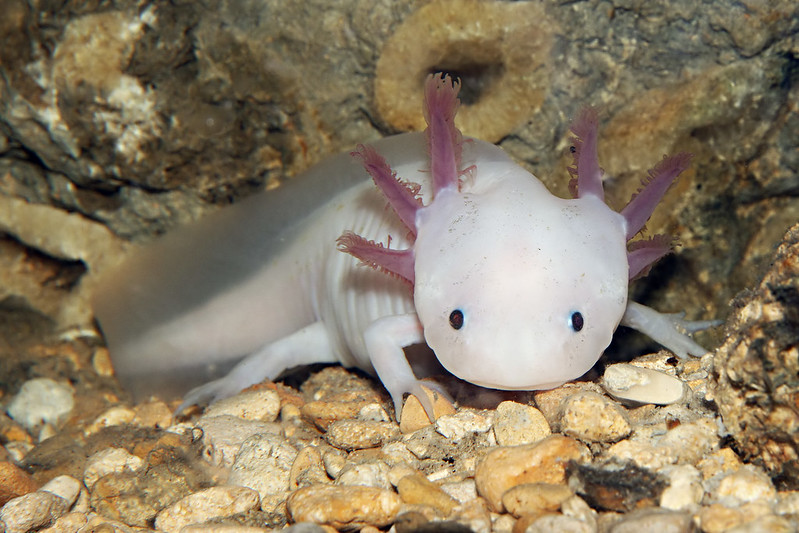
This pinkish, permanently grinning salamander can do something scientists have tried (and failed) to replicate in humans—regrow its spine, limbs, heart, lungs, and even parts of its brain. Native to the ancient canals of Xochimilco, Mexico City, the axolotl stays in a larval state for life, a condition called neoteny, which gives it that perpetual “baby dragon” look. Instead of going through metamorphosis like other amphibians, it remains aquatic and adorable, with feathery gills flaring from the sides of its head like delicate coral fans. But don’t let the cuteness fool you—this animal is a regenerative juggernaut.
When researchers sliced its spinal cord in half, the axolotl grew it back without scarring. It is the same with amputated limbs, crushed hearts, and damaged eyes. Scientists at the University of Kentucky are studying these capabilities to one day help humans regrow tissue after spinal injuries or strokes. Their secret? A cocktail of proteins and stem cells that control inflammation and cell fate with eerie precision. Some labs are even mapping the axolotl’s 32-billion base pair genome—ten times larger than ours—to unlock its secrets. So yes, this smiling little salamander might one day help you grow a new knee.
2. The Tardigrade – Space’s Toughest Tenant

Tardigrades, aka “water bears,” look like plush vacuum bags with eight stubby legs and a face only a microscope could love. But these microscopic weirdos are practically unkillable. They can survive boiling water, freezing temperatures near absolute zero, radiation blasts, crushing pressures, and even the vacuum of outer space. When things get dicey, tardigrades curl into a dehydrated ball called a “tun” and suspend their metabolism completely. They don’t age, don’t need oxygen, and can sit in this state for decades—waiting for the next chance to spring back to life.
In 2007, scientists sent tardigrades into orbit on the FOTON-M3 mission, where they endured cosmic rays and the vacuum of space for ten days and lived to tell the tale. They’ve been found thriving in Himalayan ice, hot springs, the Mariana Trench, and on mossy tree bark in your backyard. Their trick is a unique protein called Dsup (“damage suppressor”), which shields their DNA from radiation. Researchers at the University of Tokyo even spliced Dsup into human cells and saw a 40% drop in DNA damage. So, while your houseplants are gasping in the sun, tardigrades are quietly plotting interstellar immortality.
3. The Mantis Shrimp – Boxer of Blinding Light
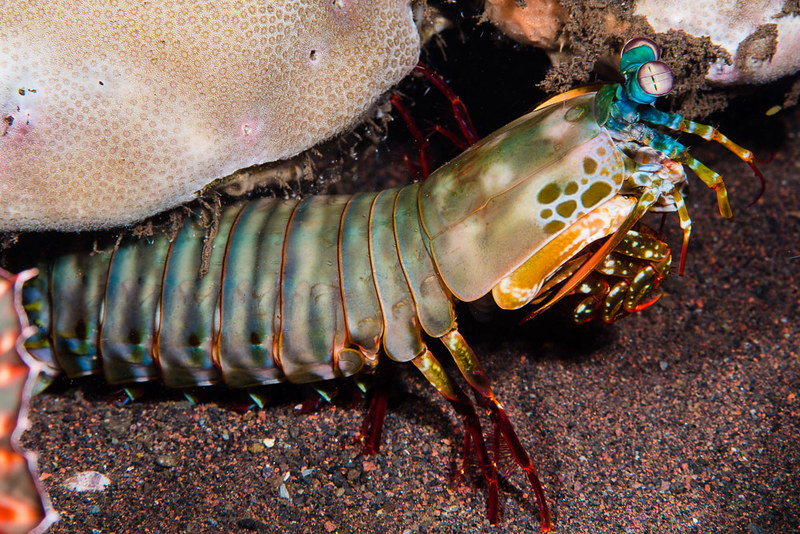
With peacock-colored shells and googly alien eyes, mantis shrimp seem more like a hallucination than a real sea creature. But their punch is the stuff of legends. Their clubbed limbs can strike with the acceleration of a bullet—about 50 mph in under three milliseconds—delivering a blow so powerful it creates superheated bubbles of plasma and a shockwave that can kill prey even if the punch misses. That means they don’t just break shells—they vaporize them. Aquariums have been known to reinforce glass tanks just to contain these aquatic bruisers.
According to researchers at Duke University and the University of California, Riverside, the mantis shrimp’s club can withstand over 100,000 high-impact punches in its lifetime without cracking, thanks to a unique helicoidal microstructure in the exoskeleton. Meanwhile, scientists at the University of Queensland have been decoding its bizarre eyes—capable of detecting polarized light and up to 12 color channels (compared to our three)—with hopes of inspiring new cameras, biomedical sensors, and even early cancer detection tools. This shrimp is a weaponized rainbow with fists faster than lightning.
4. The Immortal Jellyfish Rewinds Its Own Life

Found drifting in warm ocean waters, Turritopsis dohrnii is a jellyfish that refuses to die. This fingernail-sized wonder has the uncanny ability to revert its cells to an earlier stage of life, cycling backward from adulthood to a polyp and then starting the whole process over again. It’s like a butterfly turning back into a caterpillar and then going full butterfly again. This isn’t a trick—it’s a biological phenomenon known as transdifferentiation, and it’s rewriting what we thought we knew about aging.
Marine biologists from the University of Salento in Italy have been studying how the jellyfish rewires its genetic expression during stress or injury, essentially flipping a switch that resets its biological clock. While most creatures age in one direction, T. dohrnii seems to sidestep senescence entirely—no oxidative stress damage, no cell breakdown, no “natural causes.” Labs around the world are trying to crack the genome to see if we can apply its regeneration mechanics to human tissue repair or anti-aging medicine. While we’re dabbing on serums, this jelly is out here, Benjamin Buttoning through life.
5. The Pistol Shrimp – Blasts Bubbles That Boil
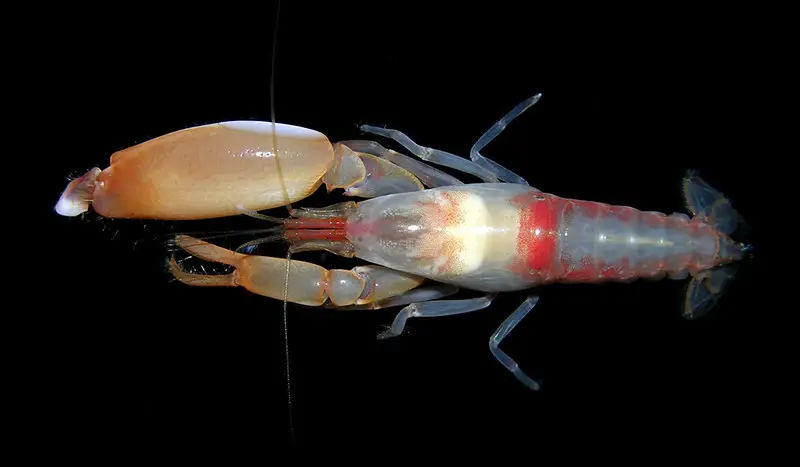
Don’t let its size fool you—this shrimp is an underwater assassin. The pistol shrimp, also called the snapping shrimp, has one oversized claw that it uses to snap so fast it creates a cavitation bubble. That bubble collapses with a sound louder than a gunshot—over 210 decibels—and generates a brief flash of light and temperatures hotter than the surface of the sun. The shockwave alone can stun or kill nearby fish, even if the claw never makes contact. It’s not hunting—it’s flash-frying.
Scientists at the University of Cambridge have analyzed the claw mechanics using high-speed videography and fluid dynamics, finding that the shrimp’s specialized joint design funnels water into a high-speed jet that creates the deadly bubble. The resulting phenomenon, called sonoluminescence, has inspired research into micro-pulse propulsion and even new treatments in cancer therapy using controlled shockwaves. And just for the record, this isn’t the same as the mantis shrimp—while both are crustacean chaos machines, the pistol shrimp snaps, the mantis shrimp punches. Either way, you do not want to arm-wrestle one.
6. The Lyrebird – Nature’s Soundboard
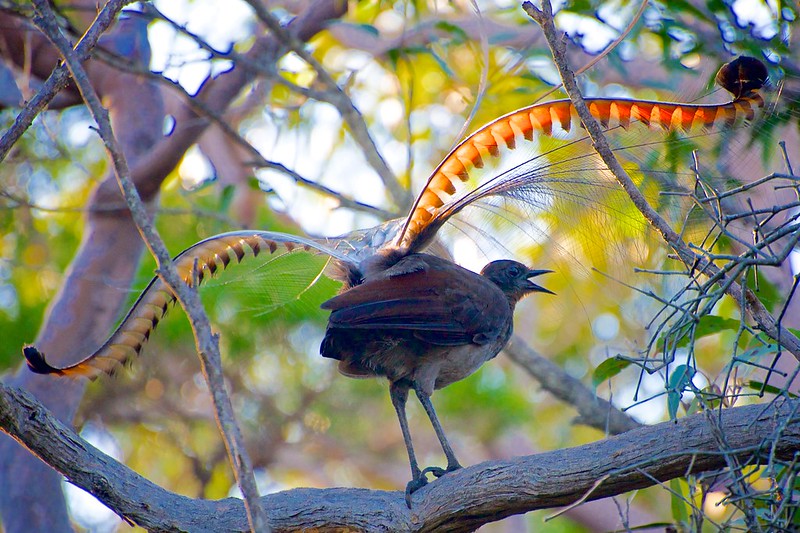
The lyrebird is an Australian icon with a talent that defies belief. While its flowing tail feathers are a visual marvel, it’s the lyrebird’s uncanny vocal mimicry that steals the show. These birds can replicate chainsaws, camera shutters, car alarms, crying babies, and even other birds’ mating calls—sometimes stringing them together into one hypnotic performance. Male lyrebirds use this skill to impress mates, turning the forest into their own surround-sound concert hall.
According to research from the Cornell Lab of Ornithology, lyrebirds have one of the most complex syrinxes in the avian world, allowing them to control sound pitch, duration, and timbre with shocking accuracy. In one long-term study published in Current Biology, lyrebirds were shown to mimic entire flocks of other birds to create an illusion of abundance, potentially manipulating both predators and mates. Even more surreal? Some captive lyrebirds have mimicked human construction sites years after leaving them—showing just how sticky their memory is. It’s not just mimicry—it’s high-level acoustic manipulation.
7. The Wood Frog – Freezes to Death, Then Wakes Up

This little amphibian from the Arctic tundra doesn’t just survive the cold—it embraces it. The wood frog can survive being frozen solid for months, with no heartbeat, no breathing, and no brain activity. Up to 70% of the water in its body turns to ice. Come spring, it thaws out, its heart restarts, and it hops off like nothing happened. It’s not a metaphor—it’s actual frog resurrection.
Scientists at the University of Alaska Fairbanks have studied how the frog’s liver floods its tissues with glucose and urea, creating a kind of natural antifreeze that prevents cells from rupturing during ice formation. The frog’s internal organs shrink, its eyes freeze over, and yet its brain remains intact and functional post-thaw. Research into its freeze tolerance has huge implications for cryogenics, especially in organ preservation and trauma medicine. This is one of the only known vertebrates to fully shut down and reboot—and it doesn’t even need jumper cables.
8. The Electric Eel – Built-in Stun Gun

Despite its name, the electric eel is a species of knifefish with one shocking party trick: it can generate bursts of electricity up to 600 volts. That’s five times the voltage in a standard U.S. wall outlet. Native to the Amazon, this predator uses electrical pulses to navigate murky water, communicate with others, and most dramatically—stun prey or scare off predators. When threatened, it can even leap out of the water and deliver a zap directly.
In 2019, researchers from Vanderbilt University discovered that electric eels use their electrical bursts in the form of high-voltage “radar,” precisely tracking the movement of prey in complete darkness. Their bodies contain thousands of electrocytes, arranged like stacked batteries, which discharge in coordinated waves. Engineers studying their anatomy are exploring ways to build bio-inspired batteries and energy-harvesting materials. So the next time your phone dies at 3%, just remember—there’s a fish in the Amazon that is the charger.
9. The Horned Lizard Shoots Blood From Its Eyes

When danger approaches, most lizards scurry. The horned lizard squirts blood from its eyeballs. This squat, desert-dwelling reptile can rupture tiny blood vessels around its eyes, shooting a foul-tasting stream of blood up to five feet in the direction of would-be predators. The blood contains chemicals that repel coyotes and foxes and is often fired alongside threat displays like puffing up and showing off its spines. It’s part performance, part projectile, all nightmare fuel.
Zoologists from Texas Christian University have found that horned lizards can perform this stunt up to five times in a row, with zero lasting damage to their eyes. The blood-squirting is part of a broader suite of defenses that includes crypsis, burrowing, and even body inflation. And while the blood is harmless to humans, it’s extremely effective on canine predators. Researchers are studying this unique circulatory control as a window into capillary pressure regulation, which could offer insights into hypertension and ocular diseases. In short, it’s both grotesque and genius.
10. The Bombardier Beetle – Insect Flamethrower
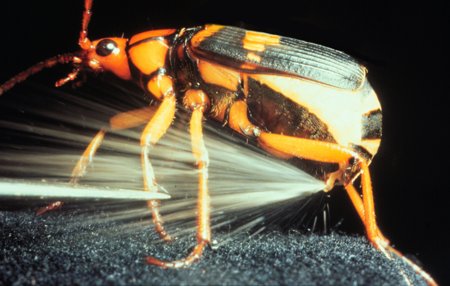
When you’re the size of a sunflower seed, being explosive helps. The bombardier beetle defends itself with a built-in chemical cannon that sprays boiling hot liquid from its abdomen. The beetle stores two harmless compounds—hydroquinone and hydrogen peroxide—in separate chambers. When threatened, it combines them in a reaction chamber, triggering an exothermic explosion that sends a scalding jet out of its rear end with audible pops and smoke.
Researchers at MIT and the University of Leeds have studied this insect’s unique defense system, noting that it releases its chemical blasts in rapid pulses rather than one continuous spray. This pulsing mechanism prevents the beetle from overheating itself—a solution that has inspired engineers to mimic it in microfluidic pumps and controlled drug delivery systems. It’s a perfect example of bioengineering in the wild. This beetle is a one-bug fireworks show with a PhD in chemistry.


